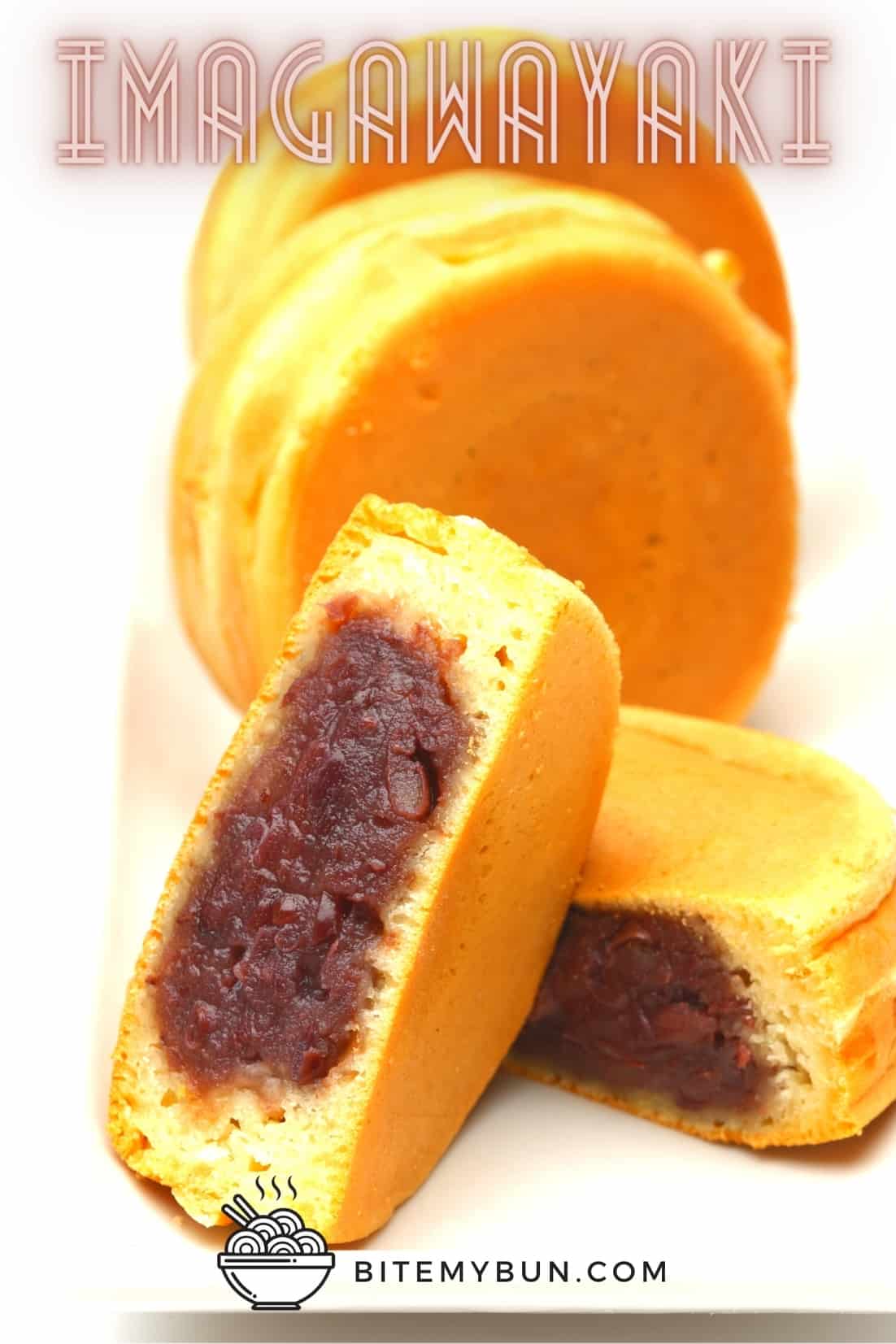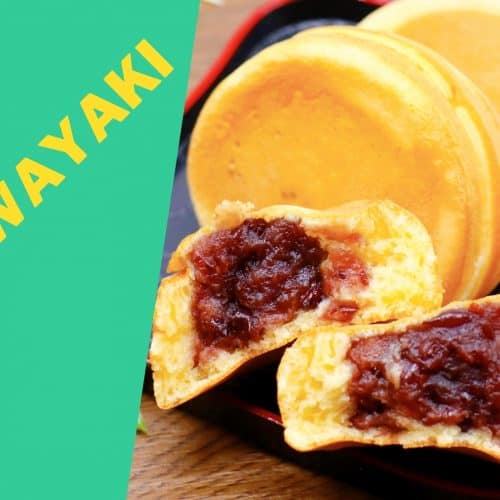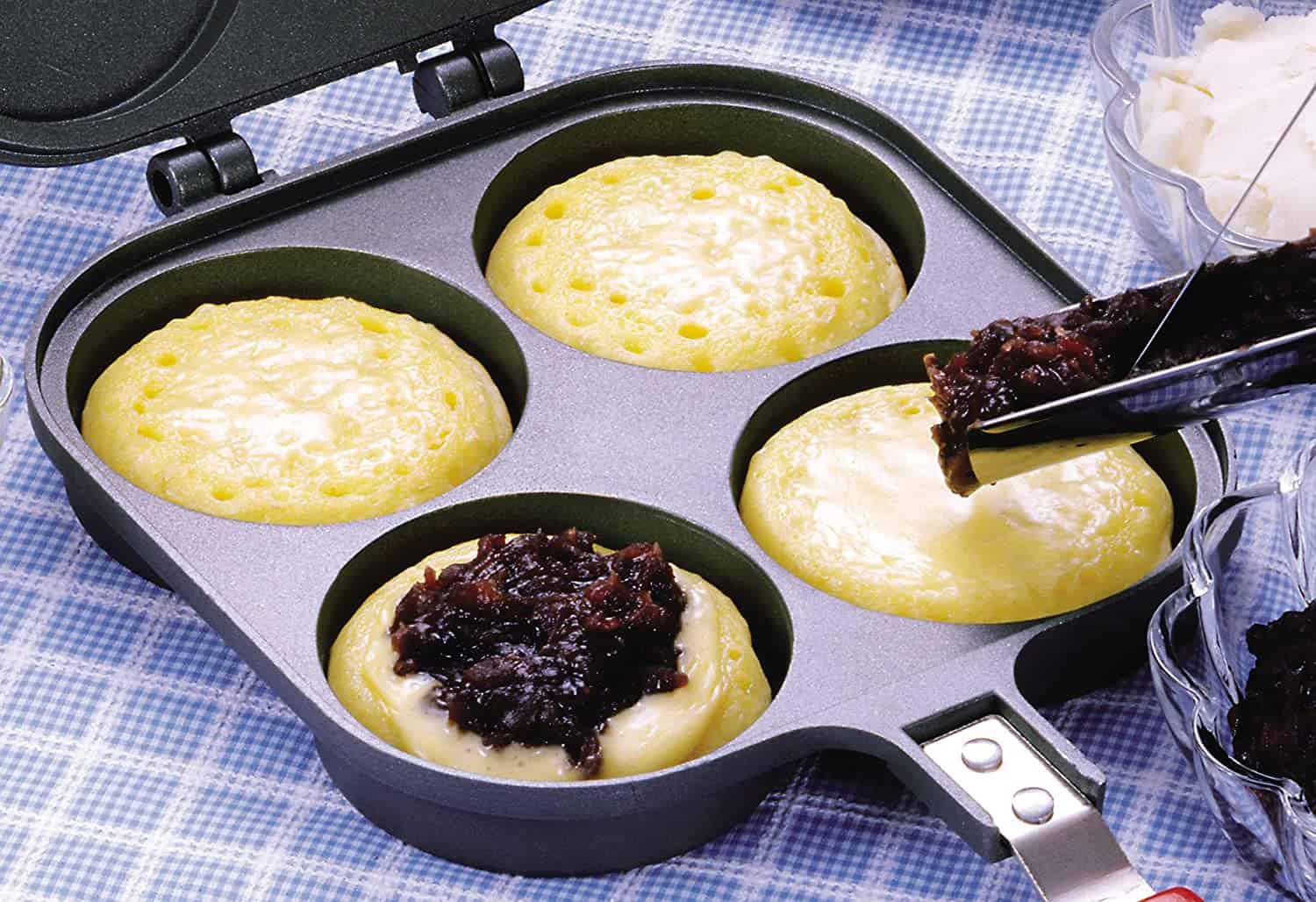Imagawayaki (obanyaki) recipe: A delicious Japanese dessert
Imagawayaki (今川焼き), also called obanyaki, is a sweet Japanese street snack with a crispy pancake-like exterior and delicious sweet red bean paste filling. This 300-year-old dessert has been a popular sweet food for centuries, and it’s still a bestseller at street food stalls around Japan.
To make imagawayaki, you pour a special pancake-like batter into a griddle pan or imagawayaki maker, add in red azuki bean paste, and another batter layer. It then becomes a stuffed fluffy pancake!

While it may sound similar to taiyaki, it’s not quite the same. First, it’s round, not fish-shaped. And second, the batter has a bit of a different texture.
Many people confuse imagawayaki with dorayaki too, which looks so similar it can be misleading. It’s also a pancake filled with red bean paste, but dorayaki is 2 pieces of pancake, and the paste is added to the middle, whereas imagawayaki is cooked with the paste inside.
Luckily, you can make this snack at home, and the recipe is quite simple. But you’ll have to get a special pan with the imagawayaki pan molds.

Check out our new cookbook
Bitemybun's family recipes with complete meal planner and recipe guide.
Try it out for free with Kindle Unlimited:
Read for freeIn this post we'll cover:
- 1 Red azuki bean imagawayaki recipe
- 2 Red azuki bean imagawayaki recipe
- 3 Are imagawayaki and obanyaki the same?
- 4 History of imagawayaki
- 5 Imagawayaki pan
- 6 How do you store imagawayaki?
- 7 Nutritional information
- 8 Popular imagawayaki fillings
- 9 How do you eat imagawayaki?
- 10 Where can you buy imagawayaki?
- 11 Enjoy this yummy snack
Red azuki bean imagawayaki recipe
Try this delicious Japanese snack at home! Most ingredients you’ll have in your pantry, except perhaps the red bean paste.
You can find this special paste here on Amazon: Koshi an (Fine Sweetened Red Bean Paste)

Red azuki bean imagawayaki recipe
Equipment
- Stovetop Imagawayaki Pan
Ingredients
- 2 eggs
- 2 cups all-purpose flour
- 1 ¼ cup milk
- 2 tbsp sugar
- 2 tbsp honey
- 2 tsp baking powder
- 16 tbsp Anko red bean paste 14 oz total or about 50-55 grams for each cake
- 1 tbsp vegetable oil
Instructions
- In a large bowl, mix the eggs and sugar.
- Add in the honey and milk, and mix until the batter is smooth.
- Add in the baking powder and sift in the flour. Then mix well.
- Let the batter rest for about 10-15 minutes.
- Scoop out the red bean paste. Take 2 tbsp for each cake and mold it into small discs. You should make 8 total.
- After your batter has rested, grease your pan and heat it to 350 F (175 C).
- Wipe away excess oil with a piece of paper towel.
- Fill each mold in the pan half full.
- Let it cook for 2 minutes.
- Place your red bean disc on 2 of the molds filled with batter. Let it cook for another 2 minutes.
- Take the set of imagawayaki that don’t have a filling, and flip them over on top of the other two that have the filling. You can use a fork or takoyaki picks to do this.
- Let them cook like that for 2 minutes, then flip each cake over and let it cook for an additional 1 or 2 minutes until it looks golden brown and crispy.
Video
Notes
Nutrition
Looking for more Japanese snack inspiration? Read about the 15 best types of Japanese snacks you need to try now
Are imagawayaki and obanyaki the same?
Both imagawayaki and obanyaki refer to the same stuffed red bean snack.
In the Tokyo and Kanto region of Japan, people call it imagawayaki, while in the Kansai region (Kyoto and Osaka), it’s called obanyaki.
History of imagawayaki
The origin of this snack is quite an interesting story.
About 300 years ago, in the Edo period (the late 1700s), it was first made and sold near the famous Imagawa Bridge at a food stall.
Since it was sold near the bridge, people knew they could always find it there, so they started calling it imagawayaki.
Obanyaki, its other name, is a nod to an old Japanese coin called oban. The cakes are round and disc-shaped, and since they resemble the shape of coins, people decided on that fitting name.
Read more about all kinds of Japanese pancakes: From sweet to savory and even a pancake drink!
Imagawayaki pan

You can use this aluminum mold pan with a lid on a direct flame or on your stovetop. It has 4 round hollow molds for the cakes.
It’s easy to hold, has a comfy grip handle, and you can use it outdoors too when you go camping!
The batter cooks pretty fast in this pan, and the best part is that it doesn’t stick to the coating if you grease it well. This pan is all you need to make this sweet dessert, and clean up is quite easy, so it’s worth the price, as it’s under $35.
You can also use it to make other foods after you’re done with the obanyaki, so it’s not just a “one dish” pan.
Check the price here on Amazon
If you can’t find adzuki beans in the shop, but would still like to try this recipe, learn about the best substitutes for adzuki beans here
How do you store imagawayaki?
It’s best to eat these hot/warm, but you can also place them in an airtight container and keep them in the fridge for a couple of days.
They can be stored in the freezer for about a month. It’s best to reheat them in the microwave or a toaster oven like one of these.
Nutritional information
One piece of imagawayaki has about 200-225 calories. It has about 43 g of carbohydrates and 4 g of protein.
The red bean paste is a source of iron and copper. But as with most desserts, it’s best to consume it moderately since it does contain sugar and honey.
Popular imagawayaki fillings
The traditional recipe calls for red bean paste filling, and honestly, it tastes so good, you might not feel the need to add anything else!
Each round cake is filled with a good spoonful of this semi-sweet paste. But did you know that there are two types of adzuki red bean paste?
That’s right; some people like the paste to have a thick chunky consistency (called tsubuan), while others prefer it smooth (koshian).
But as customers are constantly looking for a change and new flavors, imagawayaki makers are adding new fillings. Some like it sweet, and some are enjoying this cake with a savory and salty filling.
It’s still a snack, but it’s probably going to fill you up more.
Here are some popular ones to try:
- Matcha green tea
- Sweet vanilla custard
- Chocolate
- Curry
- Cheese
- Fruit jam
- Potato
- Mayonnaise
- Vegetables
- Meat
How do you eat imagawayaki?
Imagawayaki tastes best when served hot.
Usually, you’d buy them at snack stalls around the city and eat them with your hands as you walk around or savor them sitting down.
Once they get cold, they lose that crispiness on the outside, but they still taste yummy nonetheless.
Where can you buy imagawayaki?
Imagawayaki is sold frozen in Japanese supermarkets, and you simply warm them up and then serve them.
These are pretty yummy too, but I recommend getting them fresh from local markets and street vendors so you can experience that amazing crispy crust and spongy interior.
The best imagawayaki is sold at street food stalls and snack stalls in markets or near train stations and department stores.
Enjoy this yummy snack
Until you try this tasty snack, it’s hard to imagine why it’s so popular in Japan. But once you do, you’ll no doubt enjoy that it’s sweet, but not overly so, like American syrupy and chocolatey pancakes.
So if you ever get to walk the streets of Tokyo, look for imagawayaki stalls and try the savory fillings too!
How about another exciting Asian dessert? Try this Filipino sweet ginataang monggo dessert recipe!
Check out our new cookbook
Bitemybun's family recipes with complete meal planner and recipe guide.
Try it out for free with Kindle Unlimited:
Read for freeJoost Nusselder, the founder of Bite My Bun is a content marketer, dad and loves trying out new food with Japanese food at the heart of his passion, and together with his team he's been creating in-depth blog articles since 2016 to help loyal readers with recipes and cooking tips.
